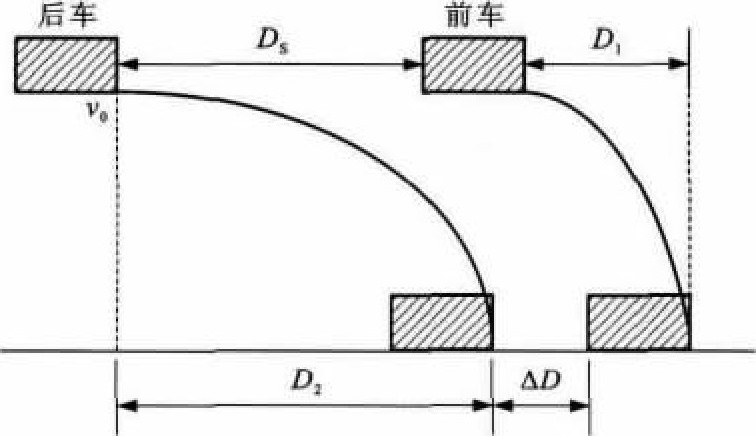Interactive evolution between safe headway and control strategy of high-speed trains during following operation
-
摘要: 为实现高速列车的安全、高效、平稳运行, 利用Petri网描述与分析了给定跟驰状态下高速列车控制策略与安全车距的互动演化机理, 探讨了高速列车复杂跟驰形势下的安全车距计算问题, 建立了能够反映高速列车控制策略的停车减速运行数学模型, 提出了基于控制策略的安全车距计算方法, 以满足高速列车当前跟驰状态下行为调整的安全性、高效性和平稳(舒适) 性和有助于动态安全车距和控制策略的实时标定。在前车速度分别为250、300、350 km·h-1, 后车速度为300 km·h-1三种跟驰状态下, 计算了前后车分别采取不同的控制策略时应保持的安全车距。计算结果表明: 随着前后车控制策略的变化, 安全车距是不同的, 对列车行为调整的平稳(舒适) 性与跟驰效率的影响也存在差异; 综合考虑安全、效率和列车行为调整的平稳(舒适) 性, 宜针对高速列车不同跟驰状态重新标定不同跟驰控制策略下的安全车距, 并建立相应的数据库, 作为列车运行和控制的依据。Abstract: In order to achieve the safe, effective, and stable operation of high-speed train, the interactive evolution mechanisms between safe headways and control strategies of high-speed trains in given following states were described and analyzed by using Petri net.The calculations of safe headway of high-speed train in complex following states were discussed, and the mathematical model of parking deceleration for high-speed train based on control strategy was established.To satisfy the safety, efficiency and smoothness (comfort) of high-speed train in current following state, the calculation method of safe headway based on control strategies was presented.The calculation method was helpful for real-time calibration of dynamic safe headway and control strategies.In the three following situations that the preceding train was moving at the speeds of 250, 300 and 350 km·h-1 respectively and the speed of following train is 300 km·h-1, the safe headways were calculated when different control strategies were used for preceding and following trains.Calculation result indicates that safe headway varies for different control strategies used for preceding and following trains, and their influences on the behavioral adjustment smoothness (comfort) of following train and the following efficiency are also different.In comprehensive consideration of safety, efficiency and smoothness (comfort) of train following operation, the safe headways in the different following states should be re-calibrated according to different control strategies, and the corresponding database should be established for train operation and control.
-
表 1 库所与变迁的意义
Table 1. Significances of places and transitions

表 2 高速列车进站情形下的跟驰行为
Table 2. Following behaviors of high-speed trains pulling into station

表 3 基于加速度的舒适性评价
Table 3. Comfort evaluation based on accelerations

表 4 不同速度下基于舒适性标准计算的k值
Table 4. Calculation values of kbased on comfort standard at different speeds

表 5 前后车速度均为300 km·h-1时的安全车距
Table 5. Safe headways when preceding and following trains moving at same speed of 300 km·h-1

表 6 前后车速度分别为250、300 km·h-1时的安全车距
Table 6. Safe headways when preceding and following trains moving at speeds of 250 and 300 km·h-1 respectively

表 7 前后车速度分别为350、300 km·h-1时的安全车距
Table 7. Safe headways when preceding and following trains moving at speeds of 350 and 300 km·h-1 respectively

-
[1] HILL R J, BOND L J. Modelling moving-block railway signalling systems using discrete-event simulation[C]//IEEE. Proceedings of the 1995IEEE/ASME Joint Railroad Conference. Piscataway: IEEE, 1995: 105-111. [2] BARNEY D, HALEY D, NIKANDROS G. Calculating train braking distance[C]//Australian Computer Society. Proceedings of the Sixth Australian workshop on Safety Critical Systems and Software. Sydney: Australian Computer Society, 2001: 23-29. [3] DAVIS C R. Signal system, interlocking plants, and automatic train control on the San Francisco-Oakland Bay Bridge Railway[J]. Transactions of the American Institute of Electrical Engineers, 1940, 59 (3): 158-164. doi: 10.1109/T-AIEE.1940.5058114 [4] HILL R J. Electric railway traction. Part 4: Signalling and interlockings[J]. Power Engineering Journal, 1995, 9 (4): 201-206. doi: 10.1049/pe:19950408 [5] 张博, 钱伟, 魏东阁. 京广线郑武段区间信号机布置方案探讨[J]. 铁道通信信号, 2010, 46 (8): 23-25. https://www.cnki.com.cn/Article/CJFDTOTAL-TDTH201008006.htmZHANG Bo, QIAN Wei, WEI Dong-ge. Exploration of signal arrangement within Zhengzhou-Wuhan Section of BeijingGuangzhou Line[J]. Railway Signalling and Communication, 2010, 46 (8): 23-25. (in Chinese). https://www.cnki.com.cn/Article/CJFDTOTAL-TDTH201008006.htm [6] 张金阁. 客运专线开行普速列车对闭塞分区长度的影响研究[J]. 铁道运输与经济, 2013, 35 (1): 4-9. doi: 10.3969/j.issn.1003-1421.2013.01.002ZHANG Jin-ge. Study on influence of operating commonspeed train of DPL on length of blocking section[J]. Railway Transport and Economy, 2013, 35 (1): 4-9. (in Chinese). doi: 10.3969/j.issn.1003-1421.2013.01.002 [7] 王俊峰. 客运专线不同列车控制系统共线对通过能力的影响[J]. 北京交通大学学报, 2010, 34 (6): 1-4. https://www.cnki.com.cn/Article/CJFDTOTAL-BFJT201006002.htmWANG Jun-feng. Traffic ability impact analysis about different train control system on the same passenger dedicated line[J]. Journal of Beijing Jiaotong University, 2010, 34 (6): 1-4. (in Chinese). https://www.cnki.com.cn/Article/CJFDTOTAL-BFJT201006002.htm [8] 罗丽云, 吴汶麒. 城市轨道交通移动闭塞列车安全间隔时间分析[J]. 中国铁道科学, 2005, 26 (1): 119-123. doi: 10.3321/j.issn:1001-4632.2005.01.022LUO Li-yun, WU Wen-qi. Analysis on the safety time interval of train with movable block system in urban rail transit[J]. China Railway Science, 2005, 26 (1): 119-123. (in Chinese). doi: 10.3321/j.issn:1001-4632.2005.01.022 [9] 刘海东, 毛保华, 何天健, 等. 不同闭塞方式下城轨列车追踪运行过程及其仿真系统的研究[J]. 铁道学报, 2005, 27 (2): 120-125. https://www.cnki.com.cn/Article/CJFDTOTAL-TDXB20050200L.htmLIU Hai-dong, MAO Bao-hua, HO Tin-kin, et al. Study on tracking operations between trains of different block modes and simulation system[J]. Journal of the China Railway Society, 2005, 27 (2): 120-125. (in Chinese). https://www.cnki.com.cn/Article/CJFDTOTAL-TDXB20050200L.htm [10] 潘登, 郑应平. 高速列车追踪运行的控制机理研究[J]. 铁道学报, 2013, 35 (3): 53-61. https://www.cnki.com.cn/Article/CJFDTOTAL-TDXB201303009.htmPAN Deng, ZHENG Ying-ping. Study on the mechanism of high-speed train following operation control[J]. Journal of the China Railway Society, 2013, 35 (3): 53-61. (in Chinese). https://www.cnki.com.cn/Article/CJFDTOTAL-TDXB201303009.htm [11] TAKEUCHI H, GOODMAN C J, SONE S. Moving block signalling dynamics: performance measures and re-starting queued electric trains[J]. IEE Proceedings-Electric Power Applications, 2003, 150 (4): 483-492. [12] TAKAGI R. Synchronisation control of trains on the railway track controlled by the moving block signalling system[J]. IET Electrical Systems in Transportation, 2012, 2 (3): 130-138. [13] 潘登, 郑应平. 基于双曲函数的车辆减速策略与安全跟驰车距的计算[J]. 交通与计算机, 2007, 25 (5): 54-58. https://www.cnki.com.cn/Article/CJFDTOTAL-JTJS200705018.htmPAN Deng, ZHENG Ying-ping. Deceleration strategies of vehicles based on hyperbolic function and calculation of safe following distance between two cars[J]. Computer and Communications, 2007, 25 (5): 54-58. (in Chinese). https://www.cnki.com.cn/Article/CJFDTOTAL-JTJS200705018.htm [14] ISO 2631-1: 1997 (E), mechanical vibration and shock-evaluation of human exposure to whole—body vibration—part 1: general requirements[S]. [15] 时伟, 韦艳芳, 李兴莉. 一种基于最小可觉差的安全车距设计模型[J]. 交通运输系统工程与信息, 2011, 11 (2): 33-38. https://www.cnki.com.cn/Article/CJFDTOTAL-YSXT201102005.htmSHI Wei, WEI Yan-fang, LI Xing-li. A safety distance design model based on just noticeable difference[J]. Journal of Transportation Systems Engineering and Information Technology, 2011, 11 (2): 33-38. (in Chinese). https://www.cnki.com.cn/Article/CJFDTOTAL-YSXT201102005.htm [16] TAKASHIGE T. Signalling systems for safe railway transport[J]. Japan Railway and Transport Review, 1999 (21): 44-50. [17] VINCZE B, TARNAI G. Evolution of train control systems[R]. Budapest: Budapest University Technology and Economics, 2006. [18] MORAR S. Evolution of communication based train control worldwide[C]//IET. Proceedings of the 2012IET Professional Development Course on Railway Signalling and Control Systems. London: IET, 2012: 218-226. [19] RUMSEY A F. Developments in train control worldwide[C]//IET. Proceedings of the 2006IET Professional Development Course on Railway Signaling and Control Systems. York: IET, 2006: 223-232. [20] 潘登, 郑应平. 移动闭塞系统列车组合定位导航技术研究[J]. 控制与决策, 2008, 23 (11): 1305-1310. https://www.cnki.com.cn/Article/CJFDTOTAL-KZYC200811021.htmPAN Deng, ZHENG Ying-ping. Integrated train positioning and navigation system under moving automatic block system[J]. Control and Decision, 2008, 23 (11): 1305-1310. (in Chinese). https://www.cnki.com.cn/Article/CJFDTOTAL-KZYC200811021.htm [21] 潘登, 郑应平. 基于安全车距实时标定的列车间隔动态控制[J]. 交通运输工程学报, 2014, 14 (1): 112-118. http://transport.chd.edu.cn/article/id/201401015PAN Deng, ZHENG Ying-ping. Dynamic control of train interval based on real-time calibration of safe headway[J]. Journal of Traffic and Transportation Engineering, 2014, 14 (1): 112-118. (in Chinese). http://transport.chd.edu.cn/article/id/201401015 -





 下载:
下载:







